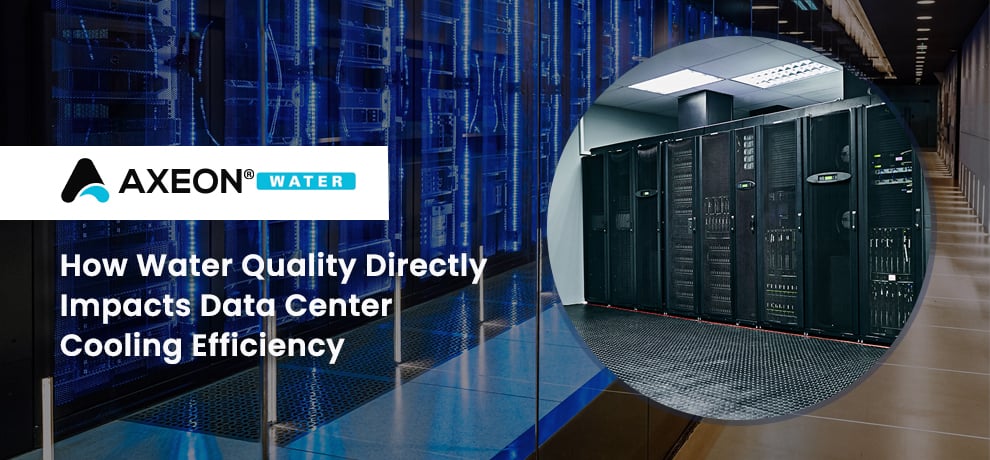Technical Articles

Data center cooling efficiency measures how effectively a cooling system removes heat from IT infrastructure while minimizing energy consumption and water usage. Water quality-defined by metrics such as total dissolved solids, hardness, pH, and microbial content-directly influences heat exchanger, cooling tower and liquid cooling performance by driving fouling, limescale accumulation and corrosion, which increase pump load and degrade overall cooling capacity.
What defines water quality for data center cooling?
Water quality for data center cooling is defined by metrics such as total dissolved solids (TDS), hardness, pH, conductivity, dissolved oxygen and microbial content.
TDS measures dissolved salts that promote limescale in heat exchangers and evaporative cooling towers.
Hardness reflects calcium and magnesium ion concentration that drives fouling and corrosion in cooling systems.
pH influences scale formation and corrosion rates, conductivity indicates ionic strength and scaling potential, and microbial load risks biofilm growth in cooling loops.
How do high dissolved solids and hardness lead to fouling and limescale?
High dissolved solids and hardness cause fouling and limescale by precipitating calcium and magnesium salts onto heat exchanger surfaces and cooling tower fill, reducing heat transfer and cooling capacity. Hard water deposits calcium carbonate when water temperature and pH rise, forming an insulating scale layer that blocks heat exchange; a 1.5-mil scale can reduce thermal efficiency by 12.5%. Scale buildup narrows flow passages and increases pressure drop, forcing pumps and fans to work harder and raising energy consumption. These effects degrade data center cooling efficiency and elevate both power usage effectiveness and water usage effectiveness.
How does poor water quality increase energy consumption?
Poor water quality increases energy consumption by forcing pumps and fans in evaporative cooling towers to work harder to compensate for reduced heat transfer, raising electricity use and worsening power usage effectiveness.
AXEON M1-Series reverse osmosis systems use 20% less energy than standard membranes by reducing total dissolved solids and hardness that drive fouling before water enters cooling loops.
Scale-induced flow restrictions increase pump head and fan power draw, making motors consume more electricity to maintain chilled water temperatures (inference based on pump affinity laws).
What role do AXEON R1-Series and X1-Series reverse osmosis systems play?
AXEON R1-Series and X1-Series systems produce high-purity water by removing total dissolved solids, hardness and microorganisms from feedwater to support data center cooling loops. R1-Series units treat 1,800–21,600 GPD with ultra low energy membranes, deliver up to 98.5% salt rejection and use 20% less energy than standard RO systems. X1-Series models process 30,000–180,000 GPD using membranes with 10% greater surface area, pre-programmed controllers, TDS probes and panel-mounted pressure and flow instrumentation for real-time water quality monitoring. By supplying purified chilled water for liquid cooling or direct liquid cooling, these RO systems prevent scale, fouling and corrosion in heat exchangers and cooling towers, enhancing cooling efficiency, reducing water consumption and optimizing power usage effectiveness in data centers.
How can data center operators measure water usage effectiveness (WUE)?
WUE quantifies liters of water consumed per kilowatt-hour of IT energy. It is calculated by dividing total annual water consumption by total IT energy usage (in kWh). For example, a WUE of 0.25 L/kWh means 0.25 liters of water are consumed to support one kilowatt-hour of data center energy. Tracking WUE enables data center operators to benchmark water efficiency, identify opportunities to reduce water use, and align cooling system performance with sustainability goals.
What sustainable water treatment strategies reduce water demand?
Data center operators can reduce fresh water demand by implementing reclaimed water, nanofiltration, membrane recycling loops and direct liquid cooling. Reclaimed wastewater undergoes tertiary treatment to meet cooling tower quality standards, turning effluent into a reliable cooling water source and alleviating freshwater stress. Advanced nanofiltration and reverse osmosis systems remove particulates, total dissolved solids and microorganisms, producing high-purity water ready for reuse, preventing fouling and corrosion in heat exchangers. Membrane recycling loops and closed-loop cooling systems embody circular economy principles, recycling 50–70% of cooling make-up water and cutting new water withdrawals. Direct liquid cooling eliminates evaporative cooling towers, further minimizing water usage in data centers.
How does improved water quality support energy efficiency?
Improved water quality prevents corrosion and scale deposits in heat exchangers and cooling towers, sustaining optimal thermal mass and heat transfer efficiency, which lowers pump head and fan power draw. Cleaner water reduces fouling-induced pressure drop, improving power usage effectiveness by up to 5% in data center cooling systems and reducing overall electricity consumption.
What best practices ensure consistent water quality management?
Routine monitoring of TDS, pH, conductivity, pump and fan pressures, and microbial content detects issues early. Scheduled chemical treatment-using scale inhibitors, corrosion inhibitors and biocides-and preventive maintenance such as heat exchanger cleaning, filter replacement, clean-in-place cycles and collaboration with water treatment experts sustain reliability, prevent fouling and corrosion, and maintain optimal cooling capacity.
Conclusion
Optimizing water quality with AXEON R1-Series and X1-Series reverse osmosis systems prevents fouling, limescale and corrosion in heat exchangers and cooling towers. This reduces pump head and fan energy consumption, improves power usage effectiveness and water usage effectiveness, and supports circular economy principles through reclaimed water integration to enhance sustainability and resilience in data center infrastructure.
THE RIGHT SOLUTION FOR YOU
Contact us today for more information about our products and services.
CONTACT US
